I first traveled to Seattle a quarter-century ago in the company of Tom Hanks and Meg Ryan. I fell in love with their movie Sleepless in Seattle and, by way of the movie, the featured city as well. Twenty-five years after, I finally got a chance to visit the Pacific Northwest metropolis in the flesh.
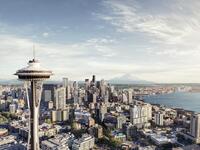 Needless to say, I fell in love with the city once more. While in this absolutely spotless and orderly city, I also made sure to visit the floating house that appeared so prominently in the film. Everywhere you look, there’s either a sea or a lake, and unlike a number of places in the States, there is not a single run-down neighborhood to find, at least not in a tourist’s sight. Again, unlike plenty of other American cities, the city center doesn’t have much of a homeless problem. And unlike the reputation that precedes it, Seattle doesn’t get a lot of rain – unlike its northern Canadian neighbor Vancouver. Cloudy days, however, are the norm.
Needless to say, I fell in love with the city once more. While in this absolutely spotless and orderly city, I also made sure to visit the floating house that appeared so prominently in the film. Everywhere you look, there’s either a sea or a lake, and unlike a number of places in the States, there is not a single run-down neighborhood to find, at least not in a tourist’s sight. Again, unlike plenty of other American cities, the city center doesn’t have much of a homeless problem. And unlike the reputation that precedes it, Seattle doesn’t get a lot of rain – unlike its northern Canadian neighbor Vancouver. Cloudy days, however, are the norm.
Come summer, many people opt to swim in nearby pristine lakes, where the water is quite warm. If you have the time, take a week in June or July and combine a trip to Seattle with a visit to Vancouver. And if you’re even more blessed with time, add a few more days in Alaska. To give you a sense of the city, jump on one of the two-hour harbor tours, which start on the sea and end at the lake, as they give you a great chance to view Seattle’s biggest landmarks. And Seattle’s restaurants? They’re fantastic, with a ready supply of terrific daily seafood. Seattle exports more seafood than any American city. Large ships from the city ply waters as far away as Alaska, where they catch fish; fishermen on board clean and freeze the catch before eventually exporting their haul from Seattle. The city’s fresh sockeye salmon, big bonito and baby tuna are fantastic, as are the daily shrimp, sea and lake crayfish and lobster; in short, it’s ground zero for a pescatarian. More than that, Seattle is also a paradise for fruits and vegetables. But whatever you do, head to the city’s premier fish market, Pike Place Market, where the fish and fruit on sale seem like they’re lifted directly from a photograph.
CANLIS
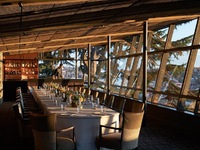 Canlis is Seattle’s best restaurant, hands down – in fact, it might even be one of the United States’ five best restaurants. Michelin doesn’t yet have any ratings for Seattle, but when it expands there, I’m fairly certain Canlis will get three stars. Likewise, Canlis isn’t on the list of the world’s 50 best restaurants, which is a shame because it should be in the top 10. Canlis opened 52 years ago in a large villa constructed by an architect with vision. It also knows a thing or two about retaining its staff; our waitress, for instance, told us she had been working at Canlis for 33 years. At Canlis, you create your own four-plate tasting menu, which you can enjoy alongside some wine from the restaurant’s well-stocked and reasonably-priced cellar. And if you’re at a loss for what to order, the sommelier is a master of his craft. Canlis’ bread and butter service is also excellent, but alas, it doesn’t have a lunch service. Unsurprisingly, it’s also difficult to find a reservation. So when you’re planning your trip to Seattle, make a reservation early, preferably for an earlier hour, as that will allow you to see the view of the city by both day and night. Canlis is open every night except Sundays.
Canlis is Seattle’s best restaurant, hands down – in fact, it might even be one of the United States’ five best restaurants. Michelin doesn’t yet have any ratings for Seattle, but when it expands there, I’m fairly certain Canlis will get three stars. Likewise, Canlis isn’t on the list of the world’s 50 best restaurants, which is a shame because it should be in the top 10. Canlis opened 52 years ago in a large villa constructed by an architect with vision. It also knows a thing or two about retaining its staff; our waitress, for instance, told us she had been working at Canlis for 33 years. At Canlis, you create your own four-plate tasting menu, which you can enjoy alongside some wine from the restaurant’s well-stocked and reasonably-priced cellar. And if you’re at a loss for what to order, the sommelier is a master of his craft. Canlis’ bread and butter service is also excellent, but alas, it doesn’t have a lunch service. Unsurprisingly, it’s also difficult to find a reservation. So when you’re planning your trip to Seattle, make a reservation early, preferably for an earlier hour, as that will allow you to see the view of the city by both day and night. Canlis is open every night except Sundays.
HARVEST BEAT
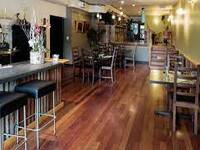 Harvest Beat is a vegan restaurant that can serve a four-plate vegan tasting menu to up to 62 people every evening (except Sundays) starting at 7. Two hours later, they handed out the bills and closed the doors. Before the meal, the young cook and owner, a young Seattleite, takes 15 minutes to explain the food and the recipes in detail. The food is truly delectable – and you needn’t be a vegan to enjoy it. But be like me and bring your own wine, as the menu is rather sparse.
Harvest Beat is a vegan restaurant that can serve a four-plate vegan tasting menu to up to 62 people every evening (except Sundays) starting at 7. Two hours later, they handed out the bills and closed the doors. Before the meal, the young cook and owner, a young Seattleite, takes 15 minutes to explain the food and the recipes in detail. The food is truly delectable – and you needn’t be a vegan to enjoy it. But be like me and bring your own wine, as the menu is rather sparse.
STAPLES & FANCY
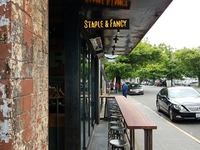 Staples & Fancy is an American-Italian restaurant with pastas and burratas at an Italian standard. It also has several varieties of sockeye salmon – which, this being Seattle, has become the fish main par excellence. The wine list is middling, but there are some nice Italian options on the menu.
Staples & Fancy is an American-Italian restaurant with pastas and burratas at an Italian standard. It also has several varieties of sockeye salmon – which, this being Seattle, has become the fish main par excellence. The wine list is middling, but there are some nice Italian options on the menu.
Make sure to save some room for dessert.
PORTAGE BAY CAFÉ
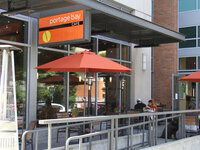 America’s breakfast/brunch culture is pervasive. With its four branches, Portage Bay offers a high-quality and broad breakfast menu from 7 till 2. But if you don’t want to wait for a while for service at one of the few places at the bar, make a reservation ahead of time. Portage Bay offers breakfast from both the menu and a buffet. Instead of breakfast, though, you can also hold off and order brunch or lunch from a larger menu.
America’s breakfast/brunch culture is pervasive. With its four branches, Portage Bay offers a high-quality and broad breakfast menu from 7 till 2. But if you don’t want to wait for a while for service at one of the few places at the bar, make a reservation ahead of time. Portage Bay offers breakfast from both the menu and a buffet. Instead of breakfast, though, you can also hold off and order brunch or lunch from a larger menu.
STARBUCKS RESERVE
Throw a stone in Seattle and it will probably land on a Starbucks – the global coffee giant that was founded in the city in 1971 before expanding to the entire planet. But look next to it (or perhaps across the street), and you’ll find the much better Seattle Coffee Works. To compete with this and other individual coffee shops, Starbucks has rebranded some of its stores as “Starbucks Reserve” shops which are more ex-pensive and offer more varieties of coffee and better sand-wiches. The flagship Starbucks Reserve in Seattle is even more fantastic. They offer delectable half pizzas and cheese-cakes, while you can also order exotic egg and omelet com-binations from the open kitchen. As for Starbucks’ first-ever branch, it can only host about 20 people at a time, but that doesn’t stop 100 or more from waiting at the door for a chance to drink coffee in the historic location. Seattle also boasts plenty of boutique creameries and artisanal chocolate stores. Of course, this also means that whenever you’re walking down the wide streets of Seattle, there are too many invi-tations to walk in and dig into a high-calorie snack.
